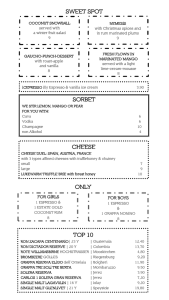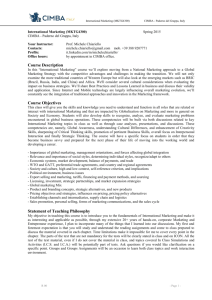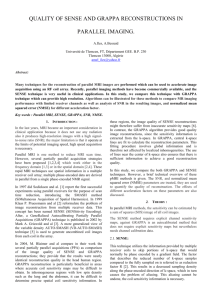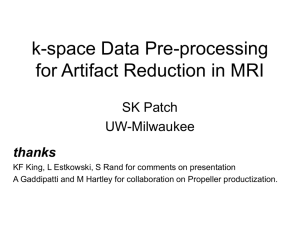Accelerated parallel magnetic resonance imaging
advertisement
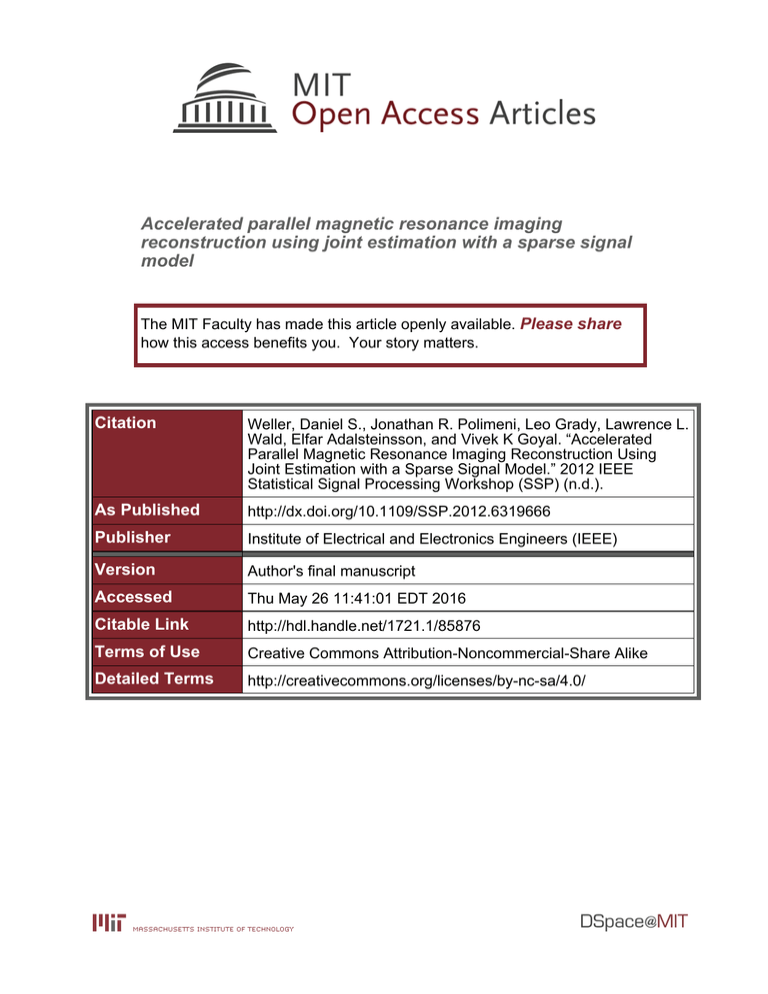
Accelerated parallel magnetic resonance imaging
reconstruction using joint estimation with a sparse signal
model
The MIT Faculty has made this article openly available. Please share
how this access benefits you. Your story matters.
Citation
Weller, Daniel S., Jonathan R. Polimeni, Leo Grady, Lawrence L.
Wald, Elfar Adalsteinsson, and Vivek K Goyal. “Accelerated
Parallel Magnetic Resonance Imaging Reconstruction Using
Joint Estimation with a Sparse Signal Model.” 2012 IEEE
Statistical Signal Processing Workshop (SSP) (n.d.).
As Published
http://dx.doi.org/10.1109/SSP.2012.6319666
Publisher
Institute of Electrical and Electronics Engineers (IEEE)
Version
Author's final manuscript
Accessed
Thu May 26 11:41:01 EDT 2016
Citable Link
http://hdl.handle.net/1721.1/85876
Terms of Use
Creative Commons Attribution-Noncommercial-Share Alike
Detailed Terms
http://creativecommons.org/licenses/by-nc-sa/4.0/
ACCELERATED PARALLEL MAGNETIC RESONANCE IMAGING RECONSTRUCTION
USING JOINT ESTIMATION WITH A SPARSE SIGNAL MODEL
Daniel S. Weller1 , Jonathan R. Polimeni2,3 , Leo Grady4 ,
Lawrence L. Wald2,3 , Elfar Adalsteinsson1 , Vivek K Goyal1
1
2
Dept. of EECS, Massachusetts Institute of Technology, Cambridge, MA, USA
A. A. Martinos Center, Dept. of Radiology, Massachusetts General Hospital, Charlestown, MA, USA
3
Dept. of Radiology, Harvard Medical School, Boston, MA, USA
4
Dept. of Image Analytics and Informatics, Siemens Corporate Research, Princeton, NJ, USA
dweller@mit.edu, jonp@nmr.mgh.harvard.edu, leo.grady@siemens.com,
wald@nmr.mgh.harvard.edu, elfar@mit.edu, vgoyal@mit.edu
ABSTRACT
Accelerating magnetic resonance imaging (MRI) by reducing the number of acquired k-space scan lines benefits
conventional MR imaging significantly by decreasing the
time subjects remain in the magnet. In this paper, we formulate a novel method for Joint estimation from Undersampled
LinEs in Parallel MRI (JULEP) that simultaneously calibrates
the GeneRalized Autocalibrating Partially Parallel Acquisitions (GRAPPA) reconstruction kernel and reconstructs the
full multi-channel k-space. We employ a joint sparsity signal
model for the channel images in conjunction with observation
models for both the acquired data and GRAPPA reconstructed
k-space. We demonstrate using real MRI data that JULEP
outperforms conventional GRAPPA reconstruction at high
levels of undersampling, increasing peak-signal-to-noise ratio by up to 10 dB.
Index Terms— Magnetic resonance imaging, image reconstruction, parallel imaging, sparsity, Bayesian estimation
1. INTRODUCTION
In conventional magnetic resonance imaging (MRI), the desired image or volume commonly is acquired by raster scanning the spatial Fourier transform domain called k-space,
sampling these scan lines, and taking the inverse Fourier
transform of these samples. MR imaging is fundamentally
limited by the time required to trace all these scan lines.
Greatly accelerating MRI by reducing the number of lines
acquired is accompanied by reductions in image quality. Accelerated parallel MRI undersamples k-space, using fewer
lines spaced farther apart, reducing the field of view (FOV),
and introducing aliasing when the object is larger than the
Funding acknowledgments: NSF CAREER Grant CCF-0643836, NIH
R01 EB007942 and EB006847, NIH NCRR P41 RR014075, Siemens Corporate Research, and an NSF Graduate Research Fellowship.
reduced FOV; parallel imaging resolves this aliasing and
produces a full-FOV image using parallel receivers.
Compressed sensing (CS) leverages the compressibility
of MR images to reconstruct images from randomly undersampled data [1]. Methods like SENSE [2], GRAPPA [3],
and SPIRiT [4] also are effective for reconstructing images
from undersampled data, but these methods are affected by
noise amplification or residual aliasing at high levels of acceleration. The synergistic combination of SENSE [5] or
SPIRiT [6] with CS aims to address the shortcomings of accelerated parallel imaging and achieve acceleration beyond
what is achievable with either approach individually.
The synergistic combination of GRAPPA with a sparsity model is more complicated due to characteristics of
GRAPPA including the presence of a calibration step, the
use of uniformly-spaced (nonrandom) undersampling, and
the reconstruction of multiple channel images rather than a
single combined image. Building upon the previous development of sparsity-based DESIGN denoising [7] of GRAPPAreconstructed data and sparsity-promoting GRAPPA kernel
calibration [8], we reinterpret the sparse reconstruction problem and devise a method for Joint estimation from Undersampled LinEs in Parallel MRI (JULEP) that elegantly unifies the
kernel calibration and full k-space reconstruction/denoising
problems with a single solution. This proposed method improves reconstruction quality at high levels of acceleration,
accommodating both greater spacing between k-space samples and fewer autocalibration (ACS) lines.
2. THEORY
Consider the N × P matrix Y, whose columns represent the
full k-space we wish to estimate for each of the P coil channels. Each of the coil images is presumed to be approximately
sparse in some appropriate transform domain with analysis
(forward) transform Ψ. Let W = ΨF−1 Y, where F is
the discrete Fourier transform; then we can impose a sparsity
model on W corresponding to the `p,q mixed norm, parameterized by λ > 0, which controls the level of sparsity:
p
p(W) ∝ e−λkWkp,q =
N
−1
Y
p
e−λk[W1 [n],...,WP [n]]kq .
(1)
n=0
To maintain convexity, we choose p = 1 (one could also impose priors for 21 < p < 1; see [9]). Setting q = 1 favors
channel-by-channel sparsity, where the support of each transformed channel image is considered independently of those of
the other channel images. For joint sparsity [10], where the
supports of each transformed channel are assumed to overlap sufficiently to gain by assuming all the channels share
the same support, we can set q = 2 (loose joint sparsity) or
q = ∞ (strict joint sparsity) to tie these channels together. In
this work, we proceed assuming loose joint sparsity and set
q = 2. Assuming W is complex,
p(W) =
N
−1
Y
n=0
P !λ2P −λk[W1 [n],...,WP [n]]k2
e
.
(2P )!π P
(2)
In accelerated MRI, the full k-space can be subdivided
into Ya = Ka Y, the acquired k-space, and Yna = Kna Y,
the un-acquired k-space. From the acquisition, we have direct
observations of acquired k-space Da , and based on the large
number of individual spins, we model our observation noise
as complex Gaussian (with real and imaginary parts uncorrelated). As the noise is typically assumed to be random perturbations due to thermal and other uncorrelated variations, we
assume this noise is iid across k-space frequency measurements, and we allow for correlation across channels for the
same frequencies. Formally,
p(Da | Y) = CN (vec(Da ); vec(Ka Y), IM ×M ⊗ Λ), (3)
where CN (·; µ, Λ) is the density function of the complex
Normal distribution with mean µ and covariance Λ, vec(·)
stacks the columns of a matrix into one vector, and ⊗ is the
Kronecker product.
Additionally, the GRAPPA reconstruction method provides observations of the un-acquired data. Given the appropriate GRAPPA kernel G, the GRAPPA reconstruction
ideally yields Yna = GRAPPA(G, Ya ). Since GRAPPA is
linear in Ya , substituting Da yields Yna + amplified noise.
Calling these GRAPPA-reconstructed observations Dna , the
likelihood of Dna given the full k-space Y is
p(Dna | Y) = CN (vec(Dna ); vec(Kna Y), ΛG ),
(4)
where the amplified noise has covariance ΛG .
Putting these signal and observation models together, the
minimum mean squared error estimator is the posterior mean
E{Y | Da , Dna }. Due to variable mixing in both the signal and observation models, this estimator does not have a
closed form, and numeric integration methods like quadrature are computationally infeasible (due to the curse of dimensionality). One could resort to stochastic methods (e.g.
importance sampling), but convergence may be rather slow
due to the number of correlated variables involved. Instead,
we propose finding the maximum a posteriori (MAP) estimate, a compressed sensing-like optimization problem:
1
Y = minimize k vec(Ka Y − Da )k2IM ×M ⊗Λ +
Y
2
1
k vec(Kna Y − Dna )k2ΛG + λkΨF−1 Yk1,2 . (5)
2
The notation kxkΛ is shorthand for kΛ−1/2 xk2 (for Hermitian symmetric positive definite Λ). This simple estimator can
be implemented and solved using various techniques, including iteratively reweighted least squares (IRLS) [11]. The use
of IRLS to solve this type of problem is carefully illustrated
in [7, 8]. This formulation effectively denoises the acquired
and GRAPPA reconstructed k-space, similar to the DESIGN
denoising method already developed.
Now, suppose the GRAPPA kernel G is now an unknown
variable, instead of simply being computed from the ACS
lines. From the matrices of source points Ys and target points
Yt from our ACS lines, with observations Ds and Dt , we add
observations of the form GDs = Yt + noise. Assuming that
the source points follow the same observation model as the
other acquired data, the noise will be complex Gaussian and
amplified by the GRAPPA kernel (call the noise covariance
ΛACS ). The optimization problem now becomes joint over
the full k-space Y and the GRAPPA kernel G:
1
{Y, G} = minimize k vec(Yt − GDs )k2ΛACS +
Y,G
2
1
k vec(Kna Y − GRAPPA(G, Da ))k2ΛG +
2
1
k vec(Ka Y − Da )k2IM ×M ⊗Λ + λkΨF−1 Yk1,2 . (6)
2
At first glance, this optimization problem has the same
form as Eq. (5); however, the covariance matrices ΛG and
ΛACS depend on G, so the first two parts of the objective are
not strictly least-squares terms, and the overall problem is not
convex. We approach the problem by fixing these covariance
matrices, applying IRLS to form an iterative algorithm, and
update the covariance matrices at the same time we update
the diagonal IRLS re-weighting matrix ∆.
1
{Y, G} = minimize k vec(Yt − GDs )k2ΛACS +
Y,G
2
1
k vec(Kna Y − GRAPPA(G, Da ))k2ΛG +
2
1
1
λ
k vec(Ka Y − Da )k2IM ×M ⊗Λ + k∆ 2 ΨF−1 Yk2F , (7)
2
2
1
where ∆n,n = k[W1 [n],...,W
, with W = ΨF−1 Y
P [n],ε]k2
from the previous iteration, and small ε > 0.
F−1
Ψ
−−−→
log |k-space|
−→
image
DWT
Fig. 1. This T1 -weighted image, acquired in the k-space domain, has a sparse four-level ‘9-7’ DWT representation.
Since Eq. (6) is not convex, convergence to a global
minimum is not guaranteed, and initialization affects the
solution. The initial full k-space is zero-filled, containing
only the acquired data, and the initial GRAPPA kernel is the
least-squares or minimum energy solution to the system of
ACS fit equations (G = Dt D†s , where D†s is the left or right
pseudo-inverse of Ds ). We anticipate convergence when
the objective decreases by less than tol percent. While this
criterion is susceptible to the possibility that updating ΛACS
and ΛG can increase the objective, such behavior did not
hamper our simulations. Although the covariance matrices
have lots of nonzero cross terms, because the GRAPPA kernel introduces correlations among k-space frequencies, we
focus on the noise amplification aspect of GRAPPA by using
a block diagonal matrix with correlations only across channels (blocks are P × P ). The JULEP method is summarized
below:
1. Set G and Y, and initialize ΛG and ΛACS .
2. Compute re-weighting matrix ∆ for the `1,2 term using
the current estimate of Y.
3. Update G and Y using an iterative solver for Eq. (7).
4. Update ΛG and ΛACS based on the new value of G.
5. Repeat steps (2)–(4) until the objective decreases by
less than tol percent.
3. METHODS
A T1 -weighted full-FOV image (256 × 256 × 176 mm FOV;
1.0 mm isotropic resolution) is acquired on a Siemens 3 T
scanner using a Siemens 32-channel receive array head coil.
An axial slice is extracted, cropped, and normalized; the combined magnitude reference image and its k-space are shown in
Fig. 1 along with its sparse transform using a four-level ‘9-7’
2-D DWT. The k-space is undersampled in both directions in
the axial plane, a 36 × 36 ACS block is retained in the center of k-space, and full-FOV images are reconstructed using
GRAPPA and the proposed method.
GRAPPA
PSNR = 20.3 dB
JULEP method
PSNR = 28.6 dB
Fig. 2. The inset images and difference images above suggest that while the GRAPPA reconstruction is very noisy, the
JULEP joint estimated image has much less noise.
The channel noise covariance matrix Λ is measured from
a separate noise-only (no RF excitation) acquisition. The reconstructed full k-space is combined to form a single combined magnitude image using the SNR-optimal coil combination based on sensitivities estimated from apodized ACS lines
and Λ. The magnitude images are compared using difference images and peak-signal-to-noise ratio (PSNR). Although
PSNR, as a non-specific measure, does not accurately reflect
image quality as perceived by a clinician, it facilitates study of
quantitative trends in image quality. A convergence threshold
of tol = 1% is used for all experiments.
4. RESULTS
In the first experiment, the T1 -weighted k-space shown in
Fig. 1 is nominally undersampled by a factor of 5 along the
coronal axis (vertical direction) and a factor of 4 along the
sagittal axis (horizontal direction), and a 36×36 block of ACS
data is retained, for an effective acceleration of R = 12.1. For
both the GRAPPA and JULEP algorithms, a GRAPPA kernel
for 5 × 4 source points is calibrated for each of the target
points. In the case of un-regularized GRAPPA kernel calibration, the calibrated kernel yields a GRAPPA-reconstructed
image with significant noise amplification in about 1 second.
The joint estimation of the kernel and full k-space produces a
reconstruction in under 80 minutes (4 IRLS steps with a total
of 555 inner iterations of the least-squares solver LSMR [12])
with far less noise than before while retaining important structural information. The inset region (outlined by the rectangle
in Fig. 1) of the reconstructed images alongside corresponding inset regions of the difference images in Fig. 2 portray a
significant difference in image quality.
This experiment is repeated on the same image for both
4×4 and 5×4 nominal undersampling, changing the effective
acceleration by varying the number of ACS lines, and comparing the magnitude image PSNRs for both GRAPPA and
joint estimation reconstructions. The trend lines portrayed
in Fig. 3 confirm that as the effective acceleration increases
due to having fewer ACS lines, the JULEP method consistently produces significantly higher quality images (as measured crudely by PSNR). The ACS block grows from 35 × 35
PSNR (dB)
Joint estimation
GRAPPA
Effective Acceleration (R)
(a) 4 × 4 nominal undersampling
PSNR (dB)
Joint estimation
imaging,” Magn. Reson. Med., vol. 58, no. 6, pp. 1182–
95, Dec. 2007.
[2] K. P. Pruessmann, M. Weiger, M. B. Scheidegger, and
P. Boesiger, “SENSE: sensitivity encoding for fast
MRI,” Magn. Reson. Med., vol. 42, no. 5, pp. 952–62,
Nov. 1999.
[3] M. A. Griswold, P. M. Jakob, R. M. Heidemann, M. Nittka, V. Jellus, J. Wang, B. Kiefer, and A. Haase, “Generalized autocalibrating partially parallel acquisitions
(GRAPPA),” Magn. Reson. Med., vol. 47, no. 6, pp.
1202–10, June 2002.
[4] M. Lustig and J. M. Pauly, “SPIRiT: Iterative selfconsistent parallel imaging reconstruction from arbitrary k-space,” Magn. Reson. Med., vol. 64, no. 2, pp.
457–471, Aug. 2010.
GRAPPA
Effective Acceleration (R)
(b) 5 × 4 nominal undersampling
Fig. 3. As the number of ACS lines varies, changing the total
acceleration, the JULEP joint estimation method consistently
outperforms the GRAPPA reconstruction in terms of PSNR.
to 48 × 48 for the 4 × 4 nominally undersampled data, and
from 42 × 42 to 48 × 48 for the 5 × 4 undersampled data. For
fewer ACS lines, the number of fit equations is insufficient
to perform a least-squares fit for the GRAPPA kernel calibration. Similar improvement in image quality is observed in the
first experiment, which uses underdetermined calibration.
5. DISCUSSION
The significant improvement in image quality achievable
by the proposed JULEP joint estimation algorithm is evident in both experiments, yielding 5-10 dB improvement
over GRAPPA. When considering the number of ACS lines
needed for a given nominal undersampling factor to achieve
a minimum PSNR, this novel estimation method can achieve
that PSNR with far fewer ACS lines. Shifting this trade-off
has implications for MRI acquisitions where maximum acceleration is desired; i.e. ACS lines are expensive. While we
cannot validate these methods clinically without extensive
evaluation of images featuring abnormalities like lesions, the
proposed method enables greater acceleration of MRI.
6. REFERENCES
[1] M. Lustig, D. Donoho, and J. M. Pauly, “Sparse MRI:
The application of compressed sensing for rapid MR
[5] D. Liang, B. Liu, J. Wang, and L. Ying, “Accelerating SENSE using compressed sensing,” Magn. Reson.
Med., vol. 62, no. 6, pp. 1574–1584, Dec. 2009.
[6] M. Lustig, M. Alley, S. Vasanawala, D. L. Donoho,
and J. M. Pauly, “L1 SPIR-iT: Autocalibrating parallel imaging compressed sensing,” in Proc. ISMRM 17th
Scientific Meeting, Apr. 2009, p. 379.
[7] D. S. Weller, J. R. Polimeni, L. Grady, L. L. Wald,
E. Adalsteinsson, and V. K Goyal, “Denoising sparse
images from GRAPPA using the nullspace method (DESIGN),” Magn. Reson. Med., to appear.
[8] D. S. Weller, J. R. Polimeni, L. Grady, L. L. Wald,
E. Adalsteinsson, and V. K Goyal, “Regularizing grappa
using simultaneous sparsity to recover de-noised images,” in Proc. SPIE Wavelets and Sparsity XIV, Aug.
2011, vol. 8138, pp. 81381M–1–9.
[9] D. S. Weller, J. R. Polimeni, L. Grady, L. L. Wald,
E. Adalsteinsson, and V. K Goyal, “Evaluating sparsity
penalty functions for combined compressed sensing and
parallel MRI,” in Proc. IEEE Int. Symp. on Biomedical
Imaging, March–April 2011, pp. 1589–92.
[10] S.F. Cotter, B.D. Rao, K. Engan, and K. KreutzDelgado, “Sparse solutions to linear inverse problems
with multiple measurement vectors,” IEEE Trans. Signal Process., vol. 53, no. 7, pp. 2477–88, July 2005.
[11] P. W. Holland and R. E. Welsch, “Robust regression
using iteratively re-weighted least-squares,” Commun.
Statist. A: Theory Meth., vol. 6, no. 9, pp. 813–827,
1977.
[12] D. C.-L. Fong and M. A. Saunders, “LSMR: An iterative
algorithm for sparse least-squares problems,” SIAM J.
Sci. Comput., vol. 33, no. 5, pp. 2950–2971, 2011.

